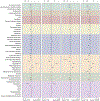Comprehensive comparative effectiveness and safety of first-line antihypertensive drug classes: a systematic, multinational, large-scale analysis
- PMID: 31668726
- PMCID: PMC6924620
- DOI: 10.1016/S0140-6736(19)32317-7
Comprehensive comparative effectiveness and safety of first-line antihypertensive drug classes: a systematic, multinational, large-scale analysis
Abstract
Background: Uncertainty remains about the optimal monotherapy for hypertension, with current guidelines recommending any primary agent among the first-line drug classes thiazide or thiazide-like diuretics, angiotensin-converting enzyme inhibitors, angiotensin receptor blockers, dihydropyridine calcium channel blockers, and non-dihydropyridine calcium channel blockers, in the absence of comorbid indications. Randomised trials have not further refined this choice.
Methods: We developed a comprehensive framework for real-world evidence that enables comparative effectiveness and safety evaluation across many drugs and outcomes from observational data encompassing millions of patients, while minimising inherent bias. Using this framework, we did a systematic, large-scale study under a new-user cohort design to estimate the relative risks of three primary (acute myocardial infarction, hospitalisation for heart failure, and stroke) and six secondary effectiveness and 46 safety outcomes comparing all first-line classes across a global network of six administrative claims and three electronic health record databases. The framework addressed residual confounding, publication bias, and p-hacking using large-scale propensity adjustment, a large set of control outcomes, and full disclosure of hypotheses tested.
Findings: Using 4·9 million patients, we generated 22 000 calibrated, propensity-score-adjusted hazard ratios (HRs) comparing all classes and outcomes across databases. Most estimates revealed no effectiveness differences between classes; however, thiazide or thiazide-like diuretics showed better primary effectiveness than angiotensin-converting enzyme inhibitors: acute myocardial infarction (HR 0·84, 95% CI 0·75-0·95), hospitalisation for heart failure (0·83, 0·74-0·95), and stroke (0·83, 0·74-0·95) risk while on initial treatment. Safety profiles also favoured thiazide or thiazide-like diuretics over angiotensin-converting enzyme inhibitors. The non-dihydropyridine calcium channel blockers were significantly inferior to the other four classes.
Interpretation: This comprehensive framework introduces a new way of doing observational health-care science at scale. The approach supports equivalence between drug classes for initiating monotherapy for hypertension-in keeping with current guidelines, with the exception of thiazide or thiazide-like diuretics superiority to angiotensin-converting enzyme inhibitors and the inferiority of non-dihydropyridine calcium channel blockers.
Funding: US National Science Foundation, US National Institutes of Health, Janssen Research & Development, IQVIA, South Korean Ministry of Health & Welfare, Australian National Health and Medical Research Council.
Copyright © 2019 Elsevier Ltd. All rights reserved.
Figures



Comment in
-
What is the first choice for blood pressure treatment?Lancet. 2019 Nov 16;394(10211):1782-1784. doi: 10.1016/S0140-6736(19)32461-4. Epub 2019 Oct 24. Lancet. 2019. PMID: 31668725 No abstract available.
-
Comparable Effectiveness of Common Antihypertensive Medications.Am J Nurs. 2020 Mar;120(3):67. doi: 10.1097/01.NAJ.0000656364.28908.ce. Am J Nurs. 2020. PMID: 32079803 No abstract available.
References
-
- Whelton PK, Carey RM, Aronow WS, et al. 2017 ACC/AHA/AAPA/ABC/ACPM/AGS/APhA/ASH/ASPC/NMA/PCNA Guideline for the Prevention, Detection, Evaluation, and Management of High Blood Pressure in Adults: Executive Summary: A Report of the American College of Cardiology/American Heart Association Task Force on Clinical Practice Guidelines. Circulation 2018;138(17):e426–83. - PubMed
-
- Williams B, Mancia G, Spiering W, et al. 2018 ESC/ESH Guidelines for the management of arterial hypertension. Eur Heart J 2018;39(33):3021–104. - PubMed
-
- The ALLHAT Officers and Coordinators for the ALLHAT Collaborative Research Group. Major Outcomes in High-Risk Hypertensive Patients Randomized to Angiotensin-Converting Enzyme Inhibitor or Calcium Channel Blocker vs Diuretic: The Antihypertensive and Lipid-Lowering Treatment to Prevent Heart Attack Trial (ALLHAT). JAMA 2002;288(23):2981–97. - PubMed
-
- Reboussin DM, Allen NB, Griswold ME, et al. Systematic Review for the 2017 ACC/AHA/AAPA/ABC/ACPM/AGS/APhA/ASH/ASPC/NMA/PCNA Guideline for the Prevention, Detection, Evaluation, and Management of High Blood Pressure in Adults: A Report of the American College of Cardiology/American Heart Association Task Force on Clinical Practice Guidelines. Circulation 2018;138(17):e595–616. - PubMed

